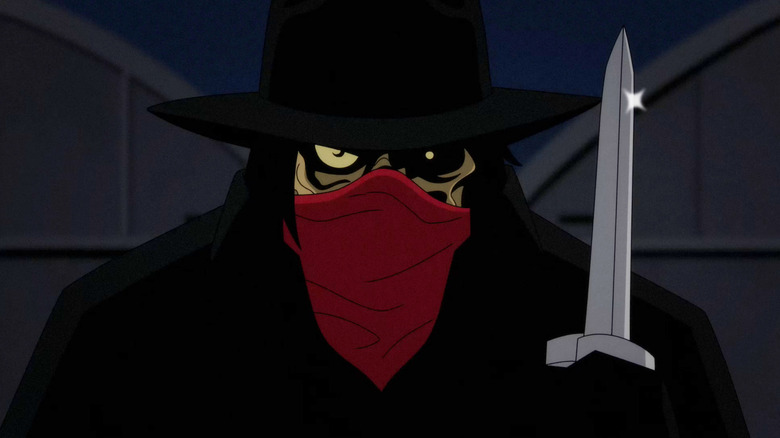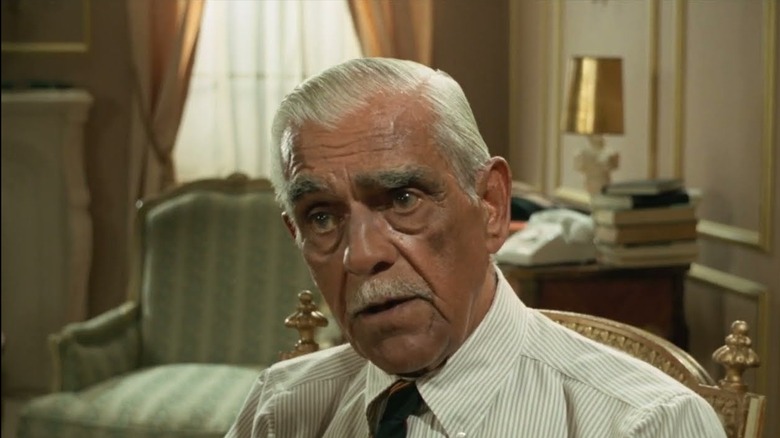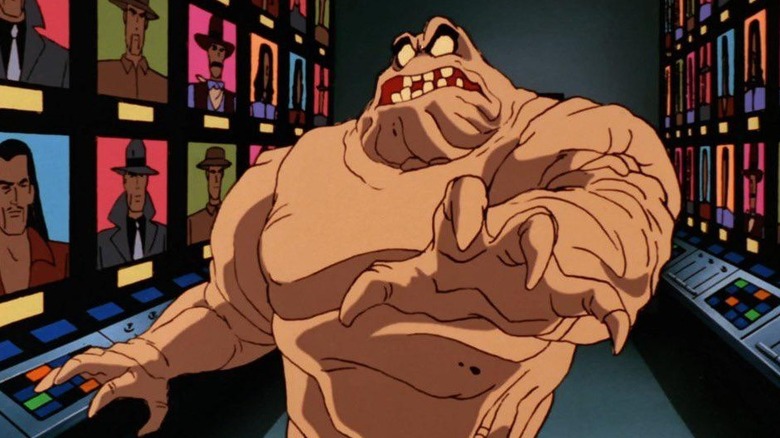One Batman: Caped Crusader Villain Is Based On A Legendary Horror Actor
This article contains spoilers for "Batman: Caped Crusader."
"Batman: Caped Crusader" promised to reinvent some of Batman's biggest villains and the 10-episode first season delivered. The Penguin is reimagined as a woman (Oswalda Cobblepot) while Harvey Dent actually becomes a better man once he's turned into Two-Face. With Clayface, the show instead goes back to his roots — but with the way the character has evolved, his original self seems unfamiliar.
Clayface is the villain of "Caped Crusader" episode 2, "... And Be A Villain" (written by prolific comic writer Greg Rucka). He is a British actor named Basil Karlo (Dan Donohue), one who has the talent but not the looks to be a leading man. Thus, he's stuck playing monsters and heels in B-horror movies. When murders and disappearances pile up around the set, Batman and Detective Renee Montoya investigate.
It turns out Karlo was funding an experimental treatment to make his face moldable like clay. His co-star, Yvonne Frances, told him he could win big parts if he were handsome. Karlo took this to mean she was interested in him, so once the treatment worked, he approached her and was spurned. Karlo snapped and began acting as Clayface, dressing and murdering like a villain right out of his movies. (To throw Batman off his scent, Karlo fakes his death by using the serum to give a dead man his own withered face.) Rucka, a noted feminist, uses Karlo to indict the entitlement of men believing that women must play the parts they cast in their heads.
Karlo's name, horror movie resume, and features are obvious references to a real actor with B.K. initials: Boris Karloff, the actor most famous for playing Frankenstein's Monster in Universal Horror films. ("Caped Crusader" is set in the 1940s, the Golden Age of the studio system in Hollywood and, evidently, Gotham City.) Unlike Karloff, Karlo is a monster offscreen too.
Boris Karloff, the king of Universal Horror
"Boris Karloff" was a stage name. (It is a little too perfectly creepy to be a horror actor's birth name.) The actor was born William Henry Pratt in Victorian England. He came up acting on stage and in silent films; he was already prolific and middle-aged when he first played Frankenstein's Monster. Karloff, who was tall with both a large head and big eyes, had the right appearance to make the Monster look more than human. His appearance remains the default look for Frankenstein's Monster almost a century later.
Most of Karloff's remaining career was in horror films. He reprised the role of the Monster in the sequels "Bride of Frankenstein" and "Son of Frankenstein." One of his last movies, Peter Bogdanovich's "Targets," is practically autobiographical. Karloff plays an aging horror star, "Byron Orlok," who is (a.) an erudite gentleman unlike any of his most famous characters and (b.) looking to retire. Orlok discovers the real world is scarier than any movie when a premiere for his latest film is targeted by a sniper serial killer.
Karlo's design in "Caped Crusader" (rectangular face, big nose, sunken eyes, and wrinkled cheeks) looks reminiscent of Karloff. While Karlo is described as ugly, Karloff was a pretty handsome man and aged with grace. Of course, when your most famous role is a repulsive monster, that reputation can bleed over. A theme of "Frankenstein" is how if you scorn someone for their appearance, that can make their soul as ugly as their face. Karlo's storyline on "Caped Crusader" feels inspired not just by Karloff the man, but by the part he's most remembered for.
The history of Clayface in Batman comics
The allusions to Karloff via Clayface aren't an invention of "Caped Crusader." The name "Basil Karlo" goes back to Clayface's debut in 1940's "Detective Comics" #40 (by Bill Finger and Bob Kane). Kane claims in the 1989 book "Batman And Me" that he came up with it by combining Boris Karloff and Basil Rathbone (most famous for playing Sherlock Holmes) and that Clayface's design (a disfigured, green-skinned man in a purple cape and wide-brim hat) was based on Lon Chaney's "Phantom of the Opera." (Keep in mind, that Kane is known to have wildly exaggerated his contributions to Batman.)
In "Detective Comics" #40, Karlo is (as in "Caped Crusader") a horror movie actor who uses one of his old characters to commit murders. His motivation is a bit different, but no less petty; he's outraged he wasn't invited to star in a remake of his film "Dread Castle." So, he assumes the costumed identity of the film's villain, Clayface, and begins killing off the new movie's cast until Batman unmasks him.
Later, a second Clayface was introduced in 1961's "Detective Comics" #298 (by Finger and Sheldon Moldoff). This one was a treasure hunter named Matt Hagen, who transformed into a shape-changing blob monster. During the 1950s-60s, Batman comics turned from pulpy Zorro/Shadow-style detective stories into ostentatious camp; the two Clayfaces exemplify that tonal shift.
"Batman: The Animated Series" combined the two Clayfaces, using Hagen's name and powers but Karlo's actor backstory. After all, it makes more thematic sense for an actor to get the power of literally turning into other people. "Caped Crusader" likewise mixes and matches; this Clayface has the original design (no mud monsters for this Batman) but some subdued shapeshifting powers; he has only a clay face but is still human besides that. This happy medium is perfect casting for the Golden Age Batman flavor "Caped Crusader" reaches for.
"Batman: Caped Crusader" season 1 is streaming on Prime Video.


